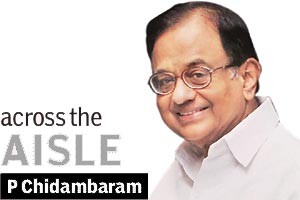Novelty of elections is passé. Elections will take place, the results will be announced, a party or an alliance will win, a government will be formed, and in a few days life will be back to the usual routine.
However, I have the feeling that post-Bihar elections, life in Bihar—and India—will not be back to the usual routine.
I have the feeling that the battle for Bihar is not a battle for capturing power in Bihar but for capturing power to rewrite the narrative of India. The battle for Bihar is not being fought only within Bihar, it is being fought in places such as Muzaffarnagar and Dadri, in states such as Maharashtra and Karnataka, and in the social and traditional media.
The four-tier arrangement
The central issue in the Bihar elections is no longer the development of Bihar, it is the cow. The cow has become the symbol of the revisionist ‘idea of India’. That idea is based on an old history of hierarchy, patriarchy, exclusion, discrimination, violence and majoritarianism.
The historical facts are bitter and brutal. For centuries, Indian society has been structured around varna, a four-tier arrangement that encompassed the majority, and also excluded a large number from the arrangement. The excluded were the outcasts or the untouchables. Inequality by birth was the basis of the arrangement. That inequality could not be changed, it stayed with you throughout your life, and it decided what you will do, what you will have and what you will be. It was the antithesis of ‘all men and women are born equal and shall have equality of opportunity’.
Besides, within the arrangement, there were rules in respect of women, marriage, food, clothing, worship, observance of rituals, etc. Violation of the rules was visited with swift punishment—usually exclusion.
The arrangement was challenged from time to time by native-born ‘reformers’ and by so-called ‘invaders’. The reformers were quickly absorbed into the arrangement and many of them were turned into icons. The invaders (who undoubtedly brought different sets of problems) were turned into objects of hate, especially if they practised another faith like Islam or Christianity.
The most powerful challenge to the arrangement was the making of the Constitution of India and the birth of a secular, democratic and liberal republic. It was an excruciatingly slow process, but thanks to the advance of adult suffrage, education, industrialisation, urbanisation and communication, the arrangement began to crumble. There was hope that India would, after all, become a more equal, just and humane society. We seemed to be learning the enduring lesson of history that only a country organised on the basis of liberty, equality and fraternity could become rich and prosperous.
The forces of darkness
The ascent to power of the BJP—with an absolute majority in the Lok Sabha—brought with it a sense of foreboding.
However, we were assured that, at the helm, was not the RSS but Mr Narendra Modi. We were told to look at Modi 2.0, the Gujarat Model, his spoken words, his energy, his enthusiastic embrace of technology, etc. For a while, the nation was impressed by Mr Modi, but questions have begun to be raised.
Why have khap panchayats become more visible and active and who has allowed them to dispense kangaroo justice?
Why is there a mushrooming of vigilante groups and moral police brigades? Why is there a rash of bans—from jeans to books to food to authors to artistes to NGOs? Why is dissent being put down with every instrument of state power? Why have eminent scholars been ousted from academic and cultural institutions? Who killed Dabholkar, Pansare and Kalburgi? Why are communal incidents on the rise (in the first half of 2015 there have been 330 incidents with 51 deaths compared to 252 incidents and 33 deaths in the first half of 2014)? Why do ministers, MPs and MLAs who have sworn to uphold the Constitution speak the language of divisiveness and hate? And, above all, why is the Prime Minister silent?
An existential threat
Mr Narendra Modi speaks on practically every subject and is usually well briefed, even if he occasionally trips (as he did on India’s GDP). He remembers birthdays and he greets sportspersons on winning a tournament. But he is ominously silent on the deliberate attempt to write a counter-narrative to the idea of a modern, secular and liberal India. His silence on the killings of Dabholkar, Pansare and Kalburgi and on the lynching of Akhlaq is unforgivable.
Indian society is more polarised today than at any time since the Partition (1947) and the demolition of the Babri masjid (1992). With the RSS and the BJP working overtime to snatch a victory in Bihar, will polarisation be complete after the elections? I shudder to think what will happen then. Recall the words of Khushwant Singh in Train to Pakistan: “Both sides killed. Both shot and stabbed and speared and clubbed. Both tortured. Both raped.”
As we wondered how long Prime Minister Modi will remain silent, he broke his eight-day silence only to offer a homily on unity and communal harmony. There was no condemnation of the killings or of the hotheads. There was no warning of action or punishment.
The nation faces a grave existential threat— polarisation on religious lines—and, regrettably, we have only Modi 1.0.
Website: pchidambaram.in
@Pchidambaram_IN





















